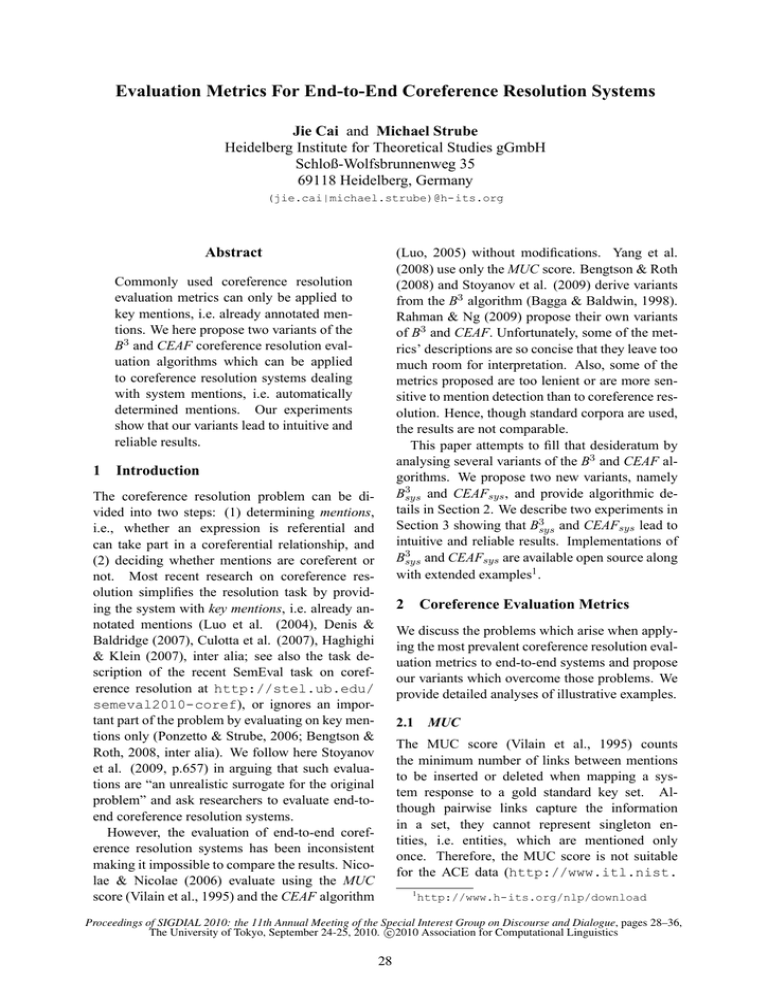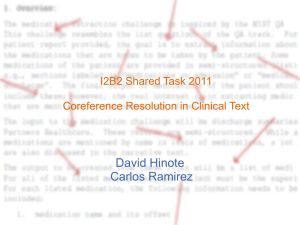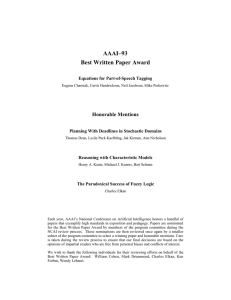Evaluation Metrics For End-to-End Coreference Resolution Systems
advertisement

Evaluation Metrics For End-to-End Coreference Resolution Systems
Jie Cai and Michael Strube
Heidelberg Institute for Theoretical Studies gGmbH
Schloß-Wolfsbrunnenweg 35
69118 Heidelberg, Germany
(jie.cai|michael.strube)@h-its.org
Abstract
(Luo, 2005) without modifications. Yang et al.
(2008) use only the MUC score. Bengtson & Roth
(2008) and Stoyanov et al. (2009) derive variants
from the B3 algorithm (Bagga & Baldwin, 1998).
Rahman & Ng (2009) propose their own variants
of B3 and CEAF. Unfortunately, some of the metrics’ descriptions are so concise that they leave too
much room for interpretation. Also, some of the
metrics proposed are too lenient or are more sensitive to mention detection than to coreference resolution. Hence, though standard corpora are used,
the results are not comparable.
This paper attempts to fill that desideratum by
analysing several variants of the B3 and CEAF algorithms. We propose two new variants, namely
B3sys and CEAFsys , and provide algorithmic details in Section 2. We describe two experiments in
Section 3 showing that B3sys and CEAFsys lead to
intuitive and reliable results. Implementations of
B3sys and CEAFsys are available open source along
with extended examples1 .
Commonly used coreference resolution
evaluation metrics can only be applied to
key mentions, i.e. already annotated mentions. We here propose two variants of the
B3 and CEAF coreference resolution evaluation algorithms which can be applied
to coreference resolution systems dealing
with system mentions, i.e. automatically
determined mentions. Our experiments
show that our variants lead to intuitive and
reliable results.
1
Introduction
The coreference resolution problem can be divided into two steps: (1) determining mentions,
i.e., whether an expression is referential and
can take part in a coreferential relationship, and
(2) deciding whether mentions are coreferent or
not. Most recent research on coreference resolution simplifies the resolution task by providing the system with key mentions, i.e. already annotated mentions (Luo et al. (2004), Denis &
Baldridge (2007), Culotta et al. (2007), Haghighi
& Klein (2007), inter alia; see also the task description of the recent SemEval task on coreference resolution at http://stel.ub.edu/
semeval2010-coref), or ignores an important part of the problem by evaluating on key mentions only (Ponzetto & Strube, 2006; Bengtson &
Roth, 2008, inter alia). We follow here Stoyanov
et al. (2009, p.657) in arguing that such evaluations are “an unrealistic surrogate for the original
problem” and ask researchers to evaluate end-toend coreference resolution systems.
However, the evaluation of end-to-end coreference resolution systems has been inconsistent
making it impossible to compare the results. Nicolae & Nicolae (2006) evaluate using the MUC
score (Vilain et al., 1995) and the CEAF algorithm
2 Coreference Evaluation Metrics
We discuss the problems which arise when applying the most prevalent coreference resolution evaluation metrics to end-to-end systems and propose
our variants which overcome those problems. We
provide detailed analyses of illustrative examples.
2.1 MUC
The MUC score (Vilain et al., 1995) counts
the minimum number of links between mentions
to be inserted or deleted when mapping a system response to a gold standard key set. Although pairwise links capture the information
in a set, they cannot represent singleton entities, i.e. entities, which are mentioned only
once. Therefore, the MUC score is not suitable
for the ACE data (http://www.itl.nist.
1
http://www.h-its.org/nlp/download
Proceedings of SIGDIAL 2010: the 11th Annual Meeting of the Special Interest Group on Discourse and Dialogue, pages 28–36,
c
The University of Tokyo, September 24-25, 2010. 2010
Association for Computational Linguistics
28
gov/iad/mig/tests/ace/), which includes
singleton entities in the keys. Moreover, the MUC
score does not give credit for separating singleton
entities from other chains. This becomes problematic in a realistic system setup, when mentions are
extracted automatically.
System 1
B30
B3all
B3r&n
B3sys
CEAFsys
2.2 B3
System 2
B3
The
algorithm (Bagga & Baldwin, 1998) overcomes the shortcomings of the MUC score. Instead of looking at the links, B3 computes precision and recall for all mentions in the document,
which are then combined to produce the final precision and recall numbers for the entire output.
For each mention, the B3 algorithm computes a
precision and recall score using equations 1 and 2:
P recision(mi ) =
Recall(mi ) =
|Rmi ∩ Kmi |
|Rmi |
|Rmi ∩ Kmi |
|Kmi |
key
response
key
response
B30
B3all
B3r&n
B3sys
CEAFsys
Set 1
{a b c}
{a b d}
P
1.0
0.556
0.556
0.667
0.5
{a b c}
{a b d e}
P
1.0
0.375
0.375
0.5
0.4
R
0.444
0.556
0.556
0.556
0.667
F
0.615
0.556
0.556
0.606
0.572
R
0.444
0.556
0.556
0.556
0.667
F
0.615
0.448
0.448
0.527
0.500
Table 1: Problems of B30
recision·Recall
(i.e. F = 2 · PPrecision+Recall
) for the example are
calculated as:
(1)
P rB 3 = 12 ( 22 + 22 ) = 1.0
0
.
RecB 3 = 31 ( 32 + 32 + 0) = 0.444
0
1.0×0.444 .
FB 3 = 2 × 1.0+0.444 = 0.615
(2)
where Rmi is the response chain (i.e. the system
output) which includes the mention mi , and Kmi
is the key chain (manually annotated gold standard) with mi . The overall precision and recall are
computed by averaging them over all mentions.
Since B3 ’s calculations are based on mentions,
singletons are taken into account. However, a
problematic issue arises when system mentions
have to be dealt with: B3 assumes the mentions in
the key and in the response to be identical. Hence,
B3 has to be extended to deal with system mentions which are not in the key and key mentions
not extracted by the system, so called twinless
mentions (Stoyanov et al., 2009).
0
B3all retains twinless system mentions. It assigns
1/|Rmi | to a twinless system mention as its precision and similarly 1/|Kmi | to a twinless key mention as its recall. For the same example above, the
B3all precision, recall and F-score are given by:
.
+ 31 ) = 0.556
.
RecB 3 = 13 ( 32 + 32 + 13 ) = 0.556
all
.
FB 3 = 2 × 0.556×0.556
= 0.556
0.556+0.444
P rB 3 = 31 ( 32 +
all
2
3
all
Tables 1, 2 and 3 illustrate the problems with B30
and B3all . The rows labeled System give the original keys and system responses while the rows labeled B30 , B3all and B3sys show the performance generated by Stoyanov et al.’s variants and the one
we introduce in this paper, B3sys (the row labeled
CEAF sys is discussed in Subsection 2.3).
In Table 1, there are two system outputs (i.e.
System 1 and System 2). Mentions d and e are
the twinless system mentions erroneously resolved
and c a twinless key mention. System 1 is supposed to be slightly better with respect to precision, because System 2 produces one more spurious resolution (i.e. for mention e ). However,
B30 computes exactly the same numbers for both
systems. Hence, there is no penalty for erroneous
coreference relations in B30 , if the mentions do not
appear in the key, e.g. putting mentions d or e in
Set 1 does not count as precision errors. — B30
is too lenient by only evaluating the correctly extacted mentions.
2.2.1 Existing B3 variants
A few variants of the B3 algorithm for dealing with
system mentions have been introduced recently.
Stoyanov et al. (2009) suggest two variants of the
B3 algorithm to deal with system mentions, B30 and
B3all 2 . For example, a key and a response are provided as below:
Key : {a b c}
Response: {a b d}
B30 discards all twinless system mentions (i.e.
mention d) and penalizes recall by setting
recallmi = 0 for all twinless key mentions (i.e.
mention c). The B30 precision, recall and F-score
Our discussion of B30 and B3all is based on the analysis
of the source code available at http://www.cs.utah.
edu/nlp/reconcile/.
2
29
System 1
key
response
B3all
B3r&n
B3sys
CEAFsys
System 2
B3all
B3r&n
B3sys
CEAFsys
key
response
Set 1
{a b c}
{a b d}
P
0.556
0.556
0.667
0.5
{a b c}
{a b d}
P
0.667
0.667
0.667
0.5
Singletons
System 1
R
0.556
0.556
0.556
0.667
{c}
R
0.556
0.556
0.556
0.667
F
0.556
0.556
0.606
0.572
key
response
B3all
B3r&n
B3sys
CEAFsys
System 2
F
0.606
0.606
0.606
0.572
key
response
B3all
B3r&n
B3sys
CEAFsys
Table 2: Problems of B3all (1)
Set 1
{a b}
{a b d}
P
0.556
0.556
0.556
0.667
{a b}
{a b d}
P
0.778
0.556
0.556
0.667
Singletons
R
1.0
1.0
1.0
1.0
F
0.715
0.715
0.715
0.800
{i} {j} {k}
R
1.0
1.0
1.0
1.0
F
0.875
0.715
0.715
0.800
Table 3: Problems of B3all (2)
B3all deals well with the problem illustrated in
Table 1, the figures reported correspond to intuition. However, B3all can output different results for identical coreference resolutions when
exposed to different mention taggers as shown in
Tables 2 and 3. B3all manages to penalize erroneous resolutions for twinless system mentions,
however, it ignores twinless key mentions when
measuring precision. In Table 2, System 1 and System 2 generate the same outputs, except that the
mention tagger in System 2 also extracts mention
c. Intuitively, the same numbers are expected for
both systems. However, B3all gives a higher precision to System 2, which results in a higher F-score.
We assume that Rahman & Ng apply a strategy
similar to B3all after the removing step (this is not
clear in Rahman & Ng (2009)). While it avoids the
problem with singleton twinless system mentions,
B3r&n still suffers from the problem dealing with
twinless key mentions, as illustrated in Table 2.
2.2.2 B3sys
We here propose a coreference resolution evaluation metric, B3sys , which deals with system mentions more adequately (see the rows labeled B3sys
in Tables 1, 2, 3, 4 and 5). We put all twinless key
mentions into the response as singletons which enables B3sys to penalize non-resolved coreferent key
mentions without penalizing non-resolved singleton key mentions, and also avoids the problem B3all
and B3r&n have as shown in Table 2. All twinless
system mentions which were deemed not coreferent (hence being singletons) are discarded. To
calculate B3sys precision, all twinless system mentions which were mistakenly resolved are put into
the key since they are spurious resolutions (equivalent to the assignment operations in B3all ), which
should be penalized by precision. Unlike B3all ,
B3sys does not benefit from unresolved twinless
system mentions (i.e. the twinless singleton system mentions). For recall, the algorithm only goes
through the original key sets, similar to B3all and
B3r&n . Details are given in Algorithm 1.
For example, a coreference resolution system
has the following key and response:
B3all retains all twinless system mentions, as can
be seen in Table 3. System 2’s mention tagger tags
more mentions (i.e. the mentions i, j and k), while
both System 1 and System 2 have identical coreference resolution performance. Still, B3all outputs
quite different results for precision and thus for Fscore. This is due to the credit B3all takes from unresolved singleton twinless system mentions (i.e.
mention i, j, k in System 2). Since the metric is expected to evaluate the end-to-end coreference system performance rather than the mention tagging
quality, it is not satisfying to observe that B3all ’s
numbers actually fluctuate when the system is exposed to different mention taggers.
Rahman & Ng (2009) apply another variant, denoted here as B3r&n . They remove only those twinless system mentions that are singletons before applying the B3 algorithm. So, a system would not
be rewarded by the the spurious mentions which
are correctly identified as singletons during resolution (as has been the case with B3all ’s higher precision for System 2 as can be seen in Table 3).
Key : {a b c}
Response: {a b d} {i j}
To calculate the precision of B3sys , the key and response are altered to:
Keyp : {a b c} {d} {i} {j}
Responsep : {a b d} {i j} {c}
30
3
Algorithm 1 Bsys
The CEAF precision and recall are derived from
the alignment which has the best total similarity
(denoted as Φ(g ∗ )), shown in Equations 5 and 6.
Input: key sets key, response sets response
Output: precision P , recall R and F-score F
1: Discard all the singleton twinless system mentions in
response;
2: Put all the twinless annotated mentions into response;
3: if calculating precision then
4:
Merge all the remaining twinless system mentions
with key to form keyp ;
5:
Use response to form responsep
6:
Through keyp and responsep ;
7:
Calculate B 3 precision P .
8: end if
9: if calculating recall then
10:
Discard all the remaining twinless system mentions in
response to from responser ;
11:
Use key to form keyr
12:
Through keyr and responser ;
13:
Calculate B 3 recall R
14: end if
15: Calculate F-score F
P recision = P
Φ(g ∗ )
i φ(Ki , Ki )
Recall = P
2
3
+
1
3
+
1
2
+
1
2
The CEAForig φ3 (⋆, ⋆) are given by:
φ3 (K1 , R1 ) = 2 (K1 : {abc}; R1 : {abd})
φ3 (K1 , K1 ) = 3
φ3 (R1 , R1 ) = 3
.
+ 1) = 0.611
So the CEAForig evaluation numbers are:
P rCEAForig = 23 = 0.667
RecCEAForig = 32 = 0.667
FCEAForig = 2 × 0.667×0.667
= 0.667
0.667+0.667
Keyr : {a b c}
Responser : {a b} {c}
The resulting recall of B3sys is:
RecBsys
=
3
+
2
3
+
1
)
3
2.3.1 Problems of CEAForig
CEAForig was intended to deal with key mentions.
Its adaptation to system mentions has not been addressed explicitly. Although CEAForig theoretically does not require to have the same number of
mentions in key and response, it still cannot be directly applied to end-to-end systems, because the
entity alignments are based on mention mappings.
As can be seen from Table 4, CEAForig fails
to produce intuitive results for system mentions.
System 2 outputs one more spurious entity (containing mention i and j) than System 1 does, however, achieves a same CEAForig precision. Since
twinless system mentions do not have mappings in
key, they contribute nothing to the mapping similarity. So, resolution mistakes for system mentions
are not calculated, and moreover, the precision is
easily skewed by the number of output entities.
CEAForig reports very low precision for system
mentions (see also Stoyanov et al. (2009)).
.
= 0.556
Thus the F-score number is calculated as:
FBsys
=2×
3
0.611×0.556
0.611+0.556
.
= 0.582
B3sys indicates more adequately the performance of
end-to-end coreference resolution systems. It is
not easily tricked by different mention taggers3 .
2.3 CEAF
Luo (2005) criticizes the B3 algorithm for using
entities more than one time, because B3 computes
precision and recall of mentions by comparing entities containing that mention. Hence Luo proposes the CEAF algorithm which aligns entities in
key and response. CEAF applies a similarity metric (which could be either mention based or entity
based) for each pair of entities (i.e. a set of mentions) to measure the goodness of each possible
alignment. The best mapping is used for calculating CEAF precision, recall and F-measure.
Luo proposes two entity based similarity metrics (Equation 3 and 4) for an entity pair (Ki , Rj )
originating from key, Ki , and response, Rj .
φ3 (Ki , Rj ) = |Ki ∩ Rj |
φ4 (Ki , Rj ) =
3
2|Ki ∩ Rj |
|Ki | + |Rj |
(6)
Key : {a b c}
Response: {a b d}
The modified key and response for recall are:
1 2
(
3 3
(5)
If not specified otherwise, we apply Luo’s φ3 (⋆, ⋆)
in the example illustrations. We denote the original CEAF algorithm as CEAForig .
Detailed calculations are illustrated below:
So, the precision of B3sys is given by:
P rBsys
= 61 ( 23 +
3
Φ(g ∗ )
i φ(Ri , Ri )
2.3.2 Existing CEAF variants
Rahman & Ng (2009) briefly introduce their
CEAF variant, which is denoted as CEAFr&n
here. They use φ3 (⋆, ⋆), which results in equal
CEAFr&n precision and recall figures when using
true mentions. Since Rahman & Ng’s experiments
using system mentions produce unequal precision
and recall figures, we assume that, after removing
(3)
(4)
Further example analyses can be found in Appendix A.
31
key
response
System 1
CEAForig
B3sys
CEAFsys
key
response
System 2
CEAForig
B3sys
CEAFsys
Set 1
{a b c}
{a b}
P
0.4
1.0
0.667
{a b c}
{a b}
P
0.4
0.8
0.6
Set 2
Singletons
System 1
R
0.667
0.556
0.667
{c} {i} {j}
F
0.500
0.715
0.667
{i j}
R
0.667
0.556
0.667
{c}
F
0.500
0.656
0.632
System 2
key
response
CEAFr&n
B3sys
CEAFsys
key
response
CEAFr&n
B3sys
CEAFsys
Table 4: Problems of CEAForig
Set 1
{a b c}
{a b}
P
0.286
0.714
0.571
{a b c}
{a b}
P
0.286
0.571
0.429
Set 2
Set 3
Singletons
{i j}
R
0.667
0.556
0.667
{k l}
F
0.400
0.625
0.615
{c}
{i j k l}
R
0.667
0.556
0.667
F
0.400
0.563
0.522
{c}
Table 5: Problems of CEAFr&n
Taking System 2 in Table 4 as an example, key and
response are altered for precision:
twinless singleton system mentions, they do not
put any twinless mentions into the other set. In the
example in Table 5, CEAFr&n does not penalize
adequately the incorrectly resolved entities consisting of twinless sytem mentions. So CEAFr&n
does not tell the difference between System 1 and
System 2. It can be concluded from the examples
that the same number of mentions in key and response is needed for computing the CEAF score.
Keyp : {a b c} {i} {j}
Responsep : {a b d} {i j} {c}
So the φ3 (⋆, ⋆) are as below, only listing the best
mappings:
φ3 (K1 , R1 ) = 2 (K1 : {abc}; R1 : {abd})
φ3 (K2 , R2 ) = 1 (K2 : {i}; R2 : {ij})
φ3 (∅, R3 ) = 0 (R3 : {c})
φ3 (R1 , R1 ) = 3
φ3 (R2 , R2 ) = 2
φ3 (R3 , R3 ) = 1
2.3.3 CEAFsys
The precision is thus give by:
We propose to adjust CEAF in the same way as
we did for B3sys , resulting in CEAF sys . We put
all twinless key mentions into the response as singletons. All singleton twinless system mentions
are discarded. For calculating CEAF sys precision,
all twinless system mentions which were mistakenly resolved are put into the key. For computing
CEAF sys recall, only the original key sets are considered. That way CEAF sys deals adequately with
system mentions (see Algorithm 2 for details).
P rCEAFsys =
2+1+0
3+2+1
= 0.6
The key and response for recall are:
Keyr : {a b c}
Responser : {a b} {c}
The resulting φ3 (⋆, ⋆) are:
φ3 (K1 , R1 ) = 2(K1 : {abc}; R1 : {ab})
φ3 (∅, R2 ) = 0(R2 : {c})
φ3 (K1 , K1 ) = 3
φ3 (R1 , R1 ) = 2
φ3 (R2 , R2 ) = 1
The recall and F-score are thus calculated as:
Algorithm 2 CEAFsys
RecCEAFsys = 23 = 0.667
= 0.632
FCEAFsys = 2 × 0.6×0.667
0.6+0.667
Input: key sets key, response sets response
Output: precision P , recall R and F-score F
1: Discard all the singleton twinless system mentions in
response;
2: Put all the twinless annotated mentions into response;
3: if calculating precision then
4:
Merge all the remaining twinless system mentions
with key to form keyp ;
5:
Use response to form responsep
6:
Form Map g ⋆ between keyp and responsep
7:
Calculate CEAF precision P using φ3 (⋆, ⋆)
8: end if
9: if calculating recall then
10:
Discard all the remaining twinless system mentions in
response to form responser ;
11:
Use key to form keyr
12:
Form Map g ⋆ between keyr and responser
13:
Calculate CEAF recall R using φ3 (⋆, ⋆)
14: end if
15: Calculate F-score F
However, one additional complication arises
with regard to the similarity metrics used by
CEAF. It turns out that only φ3 (⋆, ⋆) is suitable
for dealing with system mentions while φ4 (⋆, ⋆)
produces uninituitive results (see Table 6).
φ4 (⋆, ⋆) computes a normalized similarity for
each entity pair using the summed number of mentions in the key and the response. CEAF precision
then distributes that similarity evenly over the response set. Spurious system entities, such as the
one with mention i and j in Table 6, are not penalized. φ3 (⋆, ⋆) calculates unnormalized similarities. It compares the two systems in Table 6 adequately. Hence we use only φ3 (⋆, ⋆) in CEAF sys .
32
System 1
key
response
φ4 (⋆, ⋆)
φ3 (⋆, ⋆)
System 2
key
response
φ4 (⋆, ⋆)
φ3 (⋆, ⋆)
Set 1
{a b c}
{a b}
P
0.4
0.667
{a b c}
{a b} {i j}
P
0.489
0.6
Singletons
training
{c} {i} {j}
R
0.8
0.667
F
0.533
0.667
{c}
R
0.8
0.667
F
0.607
0.632
development
test
SM1
31,370
13,072
8,045
3,371
8,387
4,242
79.3%
57.3%
SM2
16,081
14,179
–
–
4,956
4,212
73.3%
81.2%
Table 7: Mention Taggers on ACE2004 Data
Table 6: Problems of φ4 (⋆, ⋆)
are shown in Table 7.
3.2 Artificial Setting
When normalizing the similarities by the number of entities or mentions in the key (for recall)
and the response (for precision), the CEAF algorithm considers all entities or mentions to be
equally important. Hence CEAF tends to compute
quite low precision for system mentions which
does not represent the system performance adequately. Here, we do not address this issue.
For the artificial setting we report results on the
development data using the SM1 tagger. To illustrate the stability of the evaluation metrics with
respect to different mention taggers, we reduce
the number of twinless system mentions in intervals of 10%, while correct (non-twinless) ones are
kept untouched. The coreference resolution system used is the BART (Versley et al., 2008) reimplementation of Soon et al. (2001). The results are
plotted in Figures 1 and 2.
2.4 BLANC
Recently, a new coreference resolution evaluation algorithm, BLANC, has been introduced (Recasens & Hovy, 2010). This measure implements
the Rand index (Rand, 1971) which has been originally developed to evaluate clustering methods.
The BLANC algorithm deals correctly with singleton entities and rewards correct entities according to the number of mentions. However, a basic assumption behind BLANC is, that the sum of
all coreferential and non-coreferential links is constant for a given set of mentions. This implies that
BLANC assumes identical mentions in key and response. It is not clear how to adapt BLANC to system mentions. We do not address this issue here.
3
mentions
twin mentions
mentions
twin mentions
mentions
twin mentions
head coverage
accuracy
0.85
MUC
BCubedsys
BCubed0
BCubedall
BCubedng
F-score for ACE04 Development Data
0.8
0.75
0.7
0.65
0.6
0.55
1
0.8
0.6
0.4
0.2
0
Proportion of twinless system mentions used in the experiment
Figure 1: Artificial Setting B3 Variants
Experiments
While Section 2 used toy examples to motivate our
3 and CEAF
metrics Bsys
sys , we here report results
on two larger experiments using ACE2004 data.
0.8
MUC
CEAFsys
CEAForig
CEAFng
F-score for ACE04 Development Data
0.75
3.1 Data and Mention Taggers
We use the ACE2004 (Mitchell et al., 2004) English training data which we split into three sets
following Bengtson & Roth (2008): Train (268
docs), Dev (76), and Test (107). We use two inhouse mention taggers. The first (SM1) implements a heuristic aiming at high recall. The second
(SM2) uses the J48 decision tree classifier (Witten & Frank, 2005). The number of detected mentions, head coverage, and accuracy on testing data
0.7
0.65
0.6
0.55
0.5
0.45
0.4
1
0.8
0.6
0.4
0.2
Proportion of twinless system mentions used in the experiment
Figure 2: Artificial Setting CEAF Variants
33
0
Soon (SM1)
Soon (SM2)
R
51.7
49.1
MUC
Pr
53.1
69.9
F
52.4
57.7
Soon (SM2)
Bengtson
R
64.1
66.1
3
Bsys
Pr
87.3
81.9
F
73.9
73.1
R
54.7
69.5
B03
Pr
91.3
74.7
F
68.4
72.0
Table 8: Realistic Setting MUC
Table 11: Realistic Setting
Omitting twinless system mentions from the
training data while keeping the number of correct mentions constant should improve the coreference resolution performance, because a more precise coreference resolution model is obtained. As
can be seen from Figures 1 and 2, the MUC-score,
3 and CEAF
Bsys
sys follow this intuition.
B03 is almost constant. It does not take twinless
3 ’s curve, also, has a
mentions into account. Ball
lower slope in comparison to B3sys and MUC (i.e.
B3all computes similar numbers for worse models).
3 score can be tricked by
This shows that the Ball
using a high recall mention tagger, e.g. in cases
with the worse models (i.e. ones on the left side
of the figures) which have much more twinless
system mentions. The original CEAF algorithm,
CEAForig , is too sensitive to the input system
mentions making it less reliable. CEAFsys is parallel to B3sys . Thus both of our metrics exhibit the
same intuition.
lenient by ignoring all twinless mentions.
The CEAForig numbers in Table 10 illustrate the
big influence the system mentions have on precision (e.g. the very low precision number for Soon
(SM1)). The big improvement for Soon (SM2) is
largely due to the system mentions it uses, rather
than to different coreference models.
Both B3r&n and CEAFr&n show no serious problems in the experimental results. However, as discussed before, they fail to penalize the spurious
entities with twinless system mentions adequately.
3.3.2 Experiment 2
We compare results of Bengtson & Roth’s (2008)
system with our Soon (SM2) system. Bengtson &
Roth’s embedded mention tagger aims at high precision, generating half of the mentions SM1 generates (explicit statistics are not available to us).
Bengtson & Roth report a B 3 F-score for system mentions, which is very close to the one for
true mentions. Their B 3 -variant does not impute
errors of twinless mentions and is assumed to be
quite similar to the B30 strategy.
We integrate both the B30 and B3sys variants into
their system and show results in Table 11 (we cannot report significance, because we do not have access to results for single documents in Bengtson &
Roth’s system). It can be seen that, when different
variants of evaluation metrics are applied, the performance of the systems vary wildly.
3.3 Realistic Setting
3.3.1 Experiment 1
For the realistic setting we compare SM1 and SM2
as preprocessing components for the BART (Versley et al., 2008) reimplementation of Soon et al.
(2001). The coreference resolution system with
the SM2 tagger performs better, because a better
coreference model is achieved from system mentions with higher accuracy.
The MUC, B3sys and CEAFsys metrics have the
same tendency when applied to systems with different mention taggers (Table 8, 9 and 10 and the
bold numbers are higher with a p-value of 0.05,
by a paired-t test). Since the MUC scorer does
not evaluate singleton entities, it produces too low
numbers which are not informative any more.
As shown in Table 9, B3all reports counterintuitive results when a system is fed with system
mentions generated by different mention taggers.
3 cannot be used to evaluate two different endBall
to-end coreference resolution systems, because the
mention tagger is likely to have bigger impact than
the coreference resolution system. B30 fails to generate the right comparison too, because it is too
4 Conclusions
In this paper, we address problems of commonly
used evaluation metrics for coreference resolution
and suggest two variants for B 3 and CEAF, called
3
and CEAF sys . In contrast to the variants
Bsys
3
proposed by Stoyanov et al. (2009), Bsys
and
CEAF sys are able to deal with end-to-end systems
which do not use any gold information. The num3 and CEAF
bers produced by Bsys
sys are able to
indicate the resolution performance of a system
more adequately, without being tricked easily by
twisting preprocessing components. We believe
that the explicit description of evaluation metrics,
as given in this paper, is a precondition for the re-
34
Soon (SM1)
Soon (SM2)
R
65.7
64.1
3
Bsys
Pr
76.8
87.3
F
70.8
73.9
R
57.0
54.7
B03
Pr
91.1
91.3
F
70.1
68.4
R
65.1
64.3
3
Ball
Pr
85.8
87.1
F
74.0
73.9
R
65.1
64.3
3
Br&n
Pr
78.7
84.9
F
71.2
73.2
Table 9: Realistic Setting B3 Variants
Soon (SM1)
Soon (SM2)
R
66.4
67.4
CEAFsys
Pr
61.2
65.2
F
63.7
66.3
R
62.0
60.0
CEAForig
Pr
39.9
56.6
F
48.5
58.2
R
62.1
60.0
CEAFr&n
Pr
59.8
66.2
F
60.9
62.9
Table 10: Realistic Setting CEAF Variants
liabe comparison of end-to-end coreference resolution systems.
Corpus. LDC2005T09, Philadelphia, Penn.: Linguistic
Data Consortium.
Nicolae, Cristina & Gabriel Nicolae (2006). BestCut: A
graph algorithm for coreference resolution. In Proceedings of the 2006 Conference on Empirical Methods in Natural Language Processing, Sydney, Australia, 22–23 July
2006, pp. 275–283.
Ponzetto, Simone Paolo & Michael Strube (2006). Exploiting
semantic role labeling, WordNet and Wikipedia for coreference resolution. In Proceedings of the Human Language
Technology Conference of the North American Chapter of
the Association for Computational Linguistics, New York,
N.Y., 4–9 June 2006, pp. 192–199.
Rahman, Altaf & Vincent Ng (2009). Supervised models for
coreference resolution. In Proceedings of the 2009 Conference on Empirical Methods in Natural Language Processing, Singapore, 6-7 August 2009, pp. 968–977.
Rand, William R. (1971). Objective criteria for the evaluation
of clustering methods. Journal of the American Statistical
Association, 66(336):846–850.
Recasens, Marta & Eduard Hovy (2010). BLANC: Implementing the Rand index for coreference evaluation. Submitted.
Soon, Wee Meng, Hwee Tou Ng & Daniel Chung Yong
Lim (2001). A machine learning approach to coreference
resolution of noun phrases. Computational Linguistics,
27(4):521–544.
Stoyanov, Veselin, Nathan Gilbert, Claire Cardie & Ellen
Riloff (2009). Conundrums in noun phrase coreference
resolution: Making sense of the state-of-the-art. In Proceedings of the Joint Conference of the 47th Annual Meeting of the Association for Computational Linguistics and
the 4th International Joint Conference on Natural Language Processing, Singapore, 2–7 August 2009, pp. 656–
664.
Versley, Yannick, Simone Paolo Ponzetto, Massimo Poesio,
Vladimir Eidelman, Alan Jern, Jason Smith, Xiaofeng
Yang & Alessandro Moschitti (2008). BART: A modular
toolkit for coreference resolution. In Companion Volume
to the Proceedings of the 46th Annual Meeting of the Association for Computational Linguistics, Columbus, Ohio,
15–20 June 2008, pp. 9–12.
Vilain, Marc, John Burger, John Aberdeen, Dennis Connolly
& Lynette Hirschman (1995). A model-theoretic coreference scoring scheme. In Proceedings of the 6th Message
Understanding Conference (MUC-6), pp. 45–52. San Mateo, Cal.: Morgan Kaufmann.
Witten, Ian H. & Eibe Frank (2005). Data Mining: Practical
Machine Learning Tools and Techniques (2nd ed.). San
Francisco, Cal.: Morgan Kaufmann.
Yang, Xiaofeng, Jian Su & Chew Lim Tan (2008). A twincandidate model for learning-based anaphora resolution.
Computational Linguistics, 34(3):327–356.
Acknowledgements. This work has been
funded by the Klaus Tschira Foundation, Heidelberg, Germany. The first author has been
supported by a HITS PhD. scholarship. We
would like to thank Éva Mújdricza-Maydt for
implementing the mention taggers.
References
Bagga, Amit & Breck Baldwin (1998). Algorithms for scoring coreference chains. In Proceedings of the 1st International Conference on Language Resources and Evaluation, Granada, Spain, 28–30 May 1998, pp. 563–566.
Bengtson, Eric & Dan Roth (2008). Understanding the value
of features for coreference resolution. In Proceedings of
the 2008 Conference on Empirical Methods in Natural
Language Processing, Waikiki, Honolulu, Hawaii, 25-27
October 2008, pp. 294–303.
Culotta, Aron, Michael Wick & Andrew McCallum (2007).
First-order probabilistic models for coreference resolution. In Proceedings of Human Language Technologies
2007: The Conference of the North American Chapter of
the Association for Computational Linguistics, Rochester,
N.Y., 22–27 April 2007, pp. 81–88.
Denis, Pascal & Jason Baldridge (2007). Joint determination
of anaphoricity and coreference resolution using integer
programming. In Proceedings of Human Language Technologies 2007: The Conference of the North American
Chapter of the Association for Computational Linguistics,
Rochester, N.Y., 22–27 April 2007, pp. 236–243.
Haghighi, Aria & Dan Klein (2007). Unsupervised coreference resolution in a nonparametric Bayesian model. In
Proceedings of the 45th Annual Meeting of the Association
for Computational Linguistics, Prague, Czech Republic,
23–30 June 2007, pp. 848–855.
Luo, Xiaoqiang (2005). On coreference resolution performance metrics. In Proceedings of the Human Language
Technology Conference and the 2005 Conference on Empirical Methods in Natural Language Processing, Vancouver, B.C., Canada, 6–8 October 2005, pp. 25–32.
Luo, Xiaoqiang, Abe Ittycheriah, Hongyan Jing, Nanda
Kambhatla & Salim Roukos (2004).
A mentionsynchronous coreference resolution algorithm based on
the Bell Tree. In Proceedings of the 42nd Annual Meeting of the Association for Computational Linguistics,
Barcelona, Spain, 21–26 July 2004, pp. 136–143.
Mitchell, Alexis, Stephanie Strassel, Shudong Huang &
Ramez Zakhary (2004). ACE 2004 Multilingual Training
35
A B3sys Example Output
Here, we provide additional examples for analyzing the behavior of B3sys where we systematically vary
system outputs. Since we proposed B3sys for dealing with end-to-end systems, we consider only examples
also containing twinless mentions. The systems in Table 12 and 14 generate different twinless key
mentions while keeping the twinless system mentions untouched. In Table 13 and 15, the number of
twinless system mentions changes through different responses and the number of twinless key mentions
is fixed.
In Table 12, B3sys recall goes up when more key mentions are resolved into the correct set. And the
precision stays the same, because there is no change in the number of the erroneous resolutoins (i.e. the
spurious cluster with mentions i and j). For the examples in Tables 13 and 15, B3sys gives worse precision
to the outputs with more spurious resolutions, and the same recall if the systems resolve key mentions in
the same way. Since the set of key mentions intersects with the set of twinless system mentions in Table
14, we do not have an intuitive explanation for the decrease in precision from response1 to response4 .
However, both the F-score and the recall still show the right tendency.
Set 1
{a b c d e}
{a b}
{a b c}
{a b c d}
{a b c d e}
key
response1
response2
response3
response4
B3sys
R
0.280
0.440
0.68
1.0
Set 2
P
0.857
0.857
0.857
0.857
{i j}
{i j}
{i j}
{i j}
F
0.422
0.581
0.784
0.923
Table 12: Analysis of B3sys 1
key
response1
response2
response3
response4
Set 1
{a b c d e}
{a b c}
{a b c}
{a b c}
{a b c}
Set 2
{i j}
{i j k}
{i j k l}
{i j k l m}
P
0.857
0.75
0.667
0.6
B3sys
R
0.440
0.440
0.440
0.440
F
0.581
0.555
0.530
0.508
Table 13: Analysis of B3sys 2
key
response1
response2
response3
response4
Set 1
{a b c d e}
{a b i j}
{a b c i j}
{a b c d i j}
{a b c d e i j}
P
0.643
0.6
0.571
0.551
B3sys
R
0.280
0.440
0.68
1.0
F
0.390
0.508
0.621
0.711
Table 14: Analysis of B3sys 3
key
response1
response2
response3
response4
Set 1
{a b c d e}
{a b c i j}
{a b c i j k}
{a b c i j k l}
{a b c i j k l m}
P
0.6
0.5
0.429
0.375
B3sys
R
0.440
0.440
0.440
0.440
Table 15: Analysis of B3sys 4
36
F
0.508
0.468
0.434
0.405
![Oral Presentation: Structure[1]](http://s3.studylib.net/store/data/007247236_1-34a6e756a1f0b2fa782e92987ee4471f-300x300.png)





